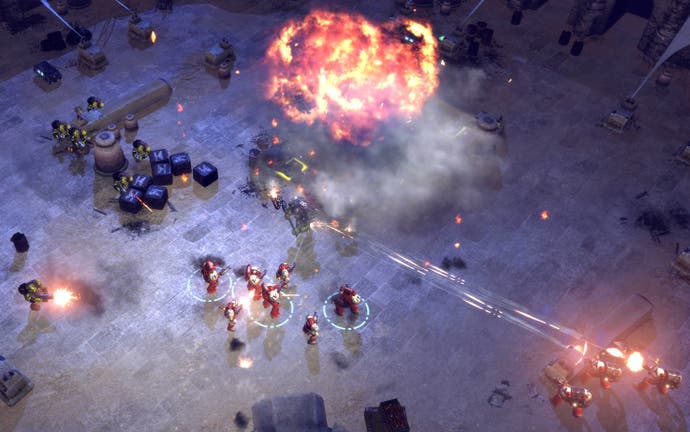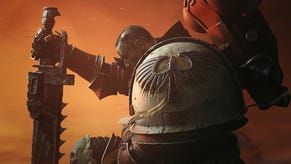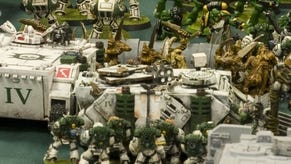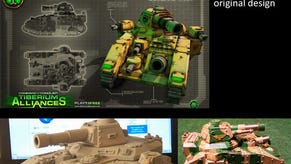Warhammer 40,000: Dawn of War II
Hail bonding.
Before long you will have more than the four-squad limit at your disposal. Then it's down to your own tactical choice which you choose - but it's handled neatly via a drag-and-drop menu pre-mission. By far our favourite is Thaddeus and his Assault Marine Squad. These jetpack-powered bad boys, once given a target, blast into the air and descend in unison, wreaking havoc as they plunge into the enemy. Satisfaction guaranteed.
While single-player is heavily weighted towards uncluttered, streamlined action, those hankering after more traditional RTS fare are catered for in multiplayer. "Some publications have mistakenly said there's no base-building in the game, there's no resource gathering," says Ebbert. "That's not true - it's still in multiplayer." This is the result of one of the most significant design decisions Relic has taken: to treat the single- and multiplayer components largely as separate games. Once more, it's all to do with the push to move the genre forward and broaden its appeal.
Ebbert credits Infinity Ward for being the first developer to deliver a game - Call of Duty 4 - that successfully tackled this issue. "They came out well after we started development, but they were the first to release and say, you know, f*** it, they're two separate games. And no-one objected. That's kind of the approach we took: multiplayer is for the more traditional. You need resource-gathering, you need base-building as a pacing mechanic." Yet even here, accessibility is the watchword. Dawn of War II multiplayer must achieve the tricky twin aims of satisfying veterans of the series while encouraging newcomers to take the plunge online. To facilitate the latter, the team has invested a lot of time in its three-versus-three Team Battle mode, which is what we play. Believing that straight one-on-one scraps intimidate less experienced gamers, co-op elements and teamwork have been built in to ensure everyone can have a blast.

Unlike the Marine-focused campaign, multiplayer offers a choice of four races: Space Marines, the Eldar, Orks and - making their long-awaited DoW debut - Tyranids. Crucially, after picking a race you must choose a hero to lead your assault. Each race has three heroes, representing different classes. Only the Space Marines are available during the playtest though. They have: Force Commander, with the formidable melee skills of his single-player counterpart; Apothecary, exclusive to multiplayer, which is the healer unit, swift to revive fallen comrades; and Tech Marine, again multiplayer-only, who knows his way around a tool kit, able to construct defences, reinforcement points and turrets.
This differs from, say, the Commander Trees of Company of Heroes, since you make the decision before entering the fray. And your choice defines your role on the battlefield. Beyond that, the territory is familiar. There are three types of strategic point scattered across the maps - Power, Requisition and, in a nod to Company of Heroes, Victory - that you have to capture while seeking to overwhelm the enemy. You can go all out to grab Victory points gradually to erode your foe's resistance. Or you can go for broke and annihilate their base for an instant win.
Progression also features in multiplayer, although unlike the Campaign, it only lasts within a single session. Heroes can be levelled up to a limit of level 10; boosting tactics include killing an opposing hero and reviving a teammate. A level-10 Force Commander, Relic assures, will "kick the ass" of one at level 1. As you'd expect, really. Meanwhile, customisation of heroes here happens during battle - with war gear becoming available as you harness more requisition and power.

The handful of games we squeeze in are riotous. Battles see-saw tantalisingly; and it's reassuring to note that even when one side is staring defeat in the face, some elegant manoeuvring can quickly turn a fight on its head. During intense, crowded encounters it's sometimes difficult to make out what is going on beneath the flaming, billowing carnage, but it's hard not to admire the pyrotechnic tour de force on display. Company of Heroes might have to defer to realism, but with Dawn of War II Relic seems intent on using the engine to pump out the biggest, most absurd fireworks display you've ever seen. And it looks fantastic. With people of all skills involved, Relic's point is made. Win or lose, the action in this brief taster is spectacular enough to satisfy you in its own right.
What's more, a further "massive reveal" on multiplayer is coming soon, Ebbert reveals. Presumably that will include a look at the announced but yet-to-be-seen co-op campaign. For now, Dawn of War II impressed us at first glance, and has impressed us again at first play. It's pure action-RTS and some may baulk at a few of the simplifications - change is often as feared as it is welcomed. Either way, it's intoxicating stuff. But Relic knows all about that.
Warhammer 40,000: Dawn of War II is due out for the PC in spring 2009.















